
Masonic, Occult and Esoteric Online Library
Legends of the Gods
By E. A. Wallis Budge
The Legend of Heru-Behutet and the Winged Disk
THE text of this legend is cut in hieroglyphics on the walls of the temple of Edfu in Upper Egypt, and certain portions of it are illustrated by large bas-reliefs. Both text and reliefs were published by Professor Naville in his volume entitled Mythe d'Horus, fol., plates 12-19, Geneva, 1870. A German translation by Brugsch appeared in the Ahandlungen der Göttinger Akademie, Band xiv., pp. 173-236, and another by Wiedemann in his Die Religion, p. 38 ff. (see the English translation p. 69 ff.). The legend, in the form in which it is here given, dates from the Ptolemaic Period, but the matter which it contains is far older,
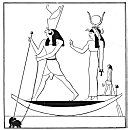
Click to enlarge
PLATE I.
Horus holding the Hippopotamus-fiend with chain and spear. Behind stand Isis and Heru Khenti-Khatti.
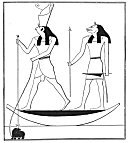
Click to enlarge
PLATE II.
Horus driving his spear into the Hippopotamus-fiend; behind him stands one of his "Blacksmiths".
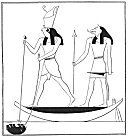
Click to enlarge
PLATE III.
Horus driving his spear into the belly of the Hippopotamus-fiend as he lies on his back; behind stands on of his "Blacksmiths".
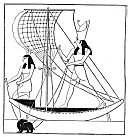
Click to enlarge
PLATE IV.
Horus and Isis capturing the Hippopotamus-fiend.
and it is probable that the facts recorded in it are fragments of actual history, which the Egyptians of the late period tried to piece together in chronological order. We shall see as we read that the writer of the legend as we have it was not well acquainted with Egyptian history, and that in his account of the conquest of Egypt he has confounded one god with another, and mixed up historical facts with mythological legends to such a degree that his meaning is frequently uncertain. The great fact which he wished to describe is the conquest of Egypt by an early king, who, having subdued the peoples in the South, advanced northwards, and made all the people whom he conquered submit to his yoke. Now the King of Egypt was always called Horus, and the priests of Edfu wishing to magnify their local god, Horus of Behutet, or Horus of Edfu, attributed to him the conquests of this human, and probably predynastic, king. We must remember that the legend assumes that Ra, was still reigning on earth, though he was old and feeble, and had probably deputed his power to his successor, whom the legend regards as his son.
In the 363rd year of his reign Ra-Harmakhis 1 was in Nubia with his army with the intention of destroying those who had conspired against him; because of their conspiracy (auu) Nubia is called "Uaua" to this day. From Nubia Ra-Harmakhis sailed down the river to Edfu, where Heru-Behutet entered his boat, and told him that his foes were conspiring against him. Ra-Harmakhis in answer addressed Heru-Behutet as his son, and commanded him to set out without delay and slay the wicked rebels. Then Heru-Behutet took the form of a great winged Disk, and at once flew up into the sky, where he took the place of Ra, the old Sun-god. Looking down from the height of heaven he was able to discover the whereabouts of the rebels, and he pursued them in the form of a winged disk. Then he attacked them with such violence that they became dazed, and could neither see where they were going, nor hear, the result of this being that they slew each other, and in a very short time they were all dead. Thoth, seeing this, told Ra that because Horus had appeared as a great winged disk he must be called "Heru-Behutet," and by this name Horus was known ever after at Edfu. Ra embraced Horus, and referred with pleasure to the blood which he had shed, and Horus invited his father to come and look upon the slain. Ra set out with the goddess Ashthertet (Ashtoreth) to do this, and they saw the enemies lying fettered on the ground. The legend here introduces a number of curious derivations of the names of Edfu, &c., which are valueless, and which remind us of the derivations of place-names propounded by ancient Semitic scribes.
In gladness of heart Ra proposed a sail on the Nile, but as soon as his enemies heard that he was coming, they changed themselves into crocodiles and hippopotami,
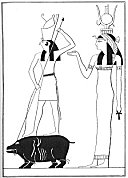
Click to enlarge
PLATE V.
Horus standing on the back of the Hippopotamus-fiend, and spearing him in the presence of Isis.
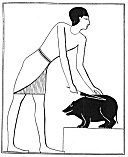
Click to enlarge
PLATE VI.
The "Butcher-priest" slicing open the Hippopotamus-fiend.
so that they might be able to wreck his boat and devour him. As the boat of the god approached them they opened their jaws to crush it, but Horus and his followers came quickly on the scene, and defeated their purpose. The followers of Horus here mentioned are called in the text "Mesniu," i.e., "blacksmiths," or "workers in metal," and they represent the primitive conquerors of the Egyptians, who were armed with metal weapons, and so were able to overcome with tolerable ease the indigenous Egyptians, whose weapons were made of flint and wood. Horus and his "blacksmiths" were provided with iron lances and chains, and, baying cast the chains over the monsters in the river, they drove their lances into their snouts, and slew 651 of them. Because Horus gained his victory by means of metal weapons, Ra decreed that a metal statue of Horus should be placed at Edfu, and remain there for ever, and a name was given to the town to commemorate the great battle that had taken place there. Ra applauded Horus for the mighty deeds which be had been able to perform by means of the spells contained in the "Book of Slaying the Hippopotamus." Horus then associated with himself the goddesses Uatchet and Nekhebet, who were in the form of serpents, and, taking his place as the winged Disk on the front of the Boat of Ra, destroyed all the enemies of Ra wheresoever he found them. When the remnant of the enemies of Ra, saw that they were likely to be slain, they doubled back to the South, but Horus pursued them, and drove them down the river before him as far as Thebes. One battle took place at Tchetmet, and another at Denderah, and Horus was always victorious; the enemies were caught by chains thrown over them, and the deadly spears of the Blacksmiths drank their blood.
After this the enemy fled to the North, and took refuge in the swamps of the Delta, and in the shallows of the Mediterranean Sea, and Horus pursued them thither. After searching for them for four days and four nights he found them, and they were speedily slain. One hundred and forty-two of them. and a male hippopotamus were dragged on to the Boat of Ra, and there Horus dug out their entrails, and hacked their carcases in pieces, which he gave to his Blacksmiths and the gods who formed the crew of the Boat of Ra. Before despatching the hippopotamus, Horus leaped on to the back of the monster as a mark of his triumph, and to commemorate this event the priest of Heben, the town wherein these things happened, was called "He who standeth on the back ever after.
The end of the great fight, however, was not yet. Another army of enemies appeared by the North Lake, and they were marching towards the sea; but terror of Horus smote their hearts, and they fled and took refuge in Mertet-Ament, where they allied themselves with the followers of Set, the Arch-fiend and great Enemy of Ra. Thither Horus and his well-armed Blacksmiths pursued them, and came up with them at the town
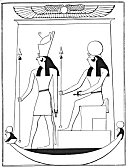
Click to enlarge
PLATE VII.
Horus of Behutet and Ra-Harmakhis in a shrine.
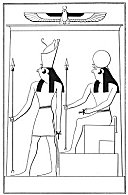
Click to enlarge
PLATE VIII.
Horus of Behutet and Harmakhis in a shrine.

Click to enlarge
PLATE IX.
Ashthertet ('Ashtoreth') driving her chariot over the prostrate foe.

Click to enlarge
PLATE X.
Left: Horus of Behutet spearing a Typhonic animal, and holding his prisoners with rope.
Right: Horus of Behutet, accompanied by Ra-Harmakhis and Menu, spearing the Hippopotamus-fiend.
called Per-Rerehu, which derived its name from the "Two Combatants," or "Two Men," Horus and Set. A great fight took place, the enemies of Ra were defeated with great slaughter, and Horus dragged 381 prisoners on to the Boat of Ra, where he slew them, and gave their bodies to his followers.
Then Set rose up and cursed Horus because he had slain his allies, and he used such foul language that Thoth called him "Nehaha-her," i.e., "Stinking Face," and this name clung to him ever after. After this Horus and Set engaged in a fight which lasted a very long time, but at length Horus drove his spear into the neck of Set with such violence that the Fiend fell headlong to the ground. Then Horus smote with his club the mouth which had uttered such blasphemies, and fettered him with his chain. In this state Horus dragged Set into the presence of Ra, who ascribed great praise to Horus, and special names were given to the palace of Horus and the high priest of the temple in commemoration of the event. When the question of the disposal of Set was being discussed by the gods, Ra ordered that he and his fiends should be given over to Isis and her son Horus, who were to do what they pleased with them. Horus promptly cut off the heads of Set and his fiends in the presence of Ra and Isis, and be dragged Set by his feet through the country with his spear sticking in his head and neck. After this Isis appointed Horus of Behutet to be the protecting deity of her son Horus.
The fight between the Sun-god and Set was a very favourite subject with Egyptian writers, and there are many forms of it. Thus there is the fight between Heru-ur and Set, the fight between Ra and Set, the fight between Heru-Behutet and Set, the fight between Osiris and Set, and the fight between Horus, son of Isis, and Set. In the oldest times the combat was merely the natural opposition of light to darkness, but later the Sun-god became the symbol of right and truth as well as of light, and Set the symbol of sin and wickedness as well as of darkness, and ultimately the nature myth was forgotten, and the fight between the two gods became the type of the everlasting war which good men wage against sin. In Coptic literature we have the well-known legend of the slaughter of the dragon by St. George, and this is nothing but a Christian adaptation of the legend of Horus and Set.
After these things Horus, son of Ra, and Horus, son of Isis, each took the form of a mighty man, with the face and body of a hawk, and each wore the Red and White Crowns, and each carried a spear and chain. In these forms the two gods slew the remnant of the enemies. Now by some means or other Set came to life again, and he took the form of a mighty hissing or "roaring" serpent, and hid himself in the ground, in a place which was ever after called the "place of the roarer." In front of his hiding-place Horus, son of Isis, stationed himself in the form of a hawk-headed staff to prevent him from coming out. In spite of this,
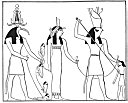
Click to enlarge
PLATE XI.
Horus of Behutet and Thoth spearing human victims with the assistance of Isis.
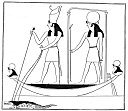
Click to enlarge
PLATE XII.
Horus of Behutet and Thoth spearing Set in the form of a crocodile.
however, Set managed to escape, and he gathered about him the Smai and Seba fiends at the Lake of Meh, and waged war once more against Horus; the enemies of Ra were again defeated, and Horus slew them in the presence of his father.
Horus, it seems, now ceased to fight for some time, and devoted himself to keeping guard over the "Great God" who was in An-rut-f, a district in or near Herakleopolis. This Great God was no other than Osiris, and the duty of Horus was to prevent the Smai fiends from coming by night to the place. In spite of the power of Horus, it was found necessary to summon the aid of Isis to keep away the fiends, and it was only by her words of power that the fiend Ba was kept out of the sanctuary. As a reward for what he had already done, Thoth decreed that Horus should be called the "Master-Fighter." Passing over the derivations of place-names which occur here in the text, we find that Horus and his Blacksmiths were again obliged to fight bodies of the enemy who had managed to escape, and that on one occasion they killed one hundred and six foes. In every fight the Blacksmiths performed mighty deeds of valour, and in reward for their services a special district was allotted to them to dwell in.
The last great fight in the North took place at Tanis, in the eastern part of the Delta. When the position of the enemy had been located, Horus took the form of a lion with the face of a man, and he put on his head the Triple Crown. His claws were like flints, and with them he dragged away one hundred and forty-two of the enemy, and tore them in pieces, and dug out their tongues, which he carried off as symbols of his victory.
Meanwhile rebellion had again broken out in Nubia, where about one-third of the enemy had taken refuge in the river in the forms of crocodiles and hippopotami. Ra counselled Horus to sail up the Nile with his Blacksmiths, and when Thoth had recited the "Chapters of protecting the Boat of Ra" over the boats, the expedition set sail for the South. The object of reciting these spells was to prevent the monsters which were in the river from making the waves to rise and from stirring up storms which might engulf the boats of Ra and Horus and the Blacksmiths. When the rebels and fiends who had been uttering, treason against Horus saw the boat of Ra, with the winged Disk of Horus accompanied by the goddesses Uatchet and Nekhebet in the form of serpents, they were smitten with fear, and their hearts quaked, and all power of resistance left them, and they died of fright straightway. When Horus returned in triumph to Edfu, Ra ordered that an image of the winged Disk should be placed in each of his sanctuaries, and that in every place wherein a winged Disk was set, that sanctuary should be a sanctuary of Horus of Behutet. The winged disks which are seen above the doorways of the temples still standing in Egypt show that the command of Ra, was faithfully carried out by the priests.
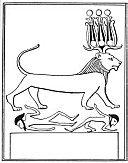
Click to enlarge
PLATE XIII.
Horus of Behutet in the form of a lion slaying his foes.
Footnotes
xxxix:1 I.e., Ra on the horizon.
